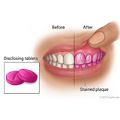Patient Education
Our Health Library information does not replace the advice of a doctor. Please be advised that this information is made available to assist our patients to learn more about their health. Our providers may not see and/or treat all topics found herein.
Self-Examination for Dental Plaque
Test Overview
A self-examination for dental plaque is done using a product that stains the plaque on your teeth. Dental plaque is a sticky film of bacteria that sticks to your teeth, the spaces between the teeth, and under your gums. It can harden into tartar. The stain lets you to see how well you are brushing and flossing your teeth.
Plaque is made of different germs (bacteria) that grow on teeth. These bacteria react with sugars and starches in foods to make acids and other substances that can cause problems and damage the teeth, gums, and bone. Acids can eat away at tooth enamel by removing minerals from the enamel (this is called demineralization).
Products you can use at home include:
- Disclosing tablets.
- Disclosing solution.
- Disclosing swabs.
These products stain plaque that was missed when you brushed and flossed along your gum lines and between your teeth. Good brushing and flossing breaks up the plaque and does not let the bacteria and acid cause problems.
Why It Is Done
Plaque forms on the teeth every day and needs to be removed. It sticks to grooves and biting surfaces of the back teeth, between the teeth, and next to the gum line.
Checking for dental plaque helps you take better care of your teeth and mouth.
How To Prepare
You will need a:
- Supply of disclosing tablets, disclosing solution, or disclosing swabs.
- Small dental mirror to check hard-to-see areas of your mouth. (A mirror is helpful but not required.)
Dental mirrors and disclosing tablets, solution, and swabs can be bought from most dentists and pharmacies.
How It Is Done
You will brush and floss your teeth. Then you will use the disclosing product. Follow the instructions on the package. Gently rinse your mouth with water. Check your teeth for plaque that has been colored with the dye. Your gums also may be stained and appear red, but this is not a problem. Use a dental mirror, if you have one, to help see behind teeth and the areas in the back of your mouth. If you find stained plaque, brush and floss again until it is gone. This helps you find areas you are missing.
Disclosing tablets
Chew a disclosing tablet and allow it to mix with your saliva. Swish the mixture around in your mouth with your tongue for about 30 seconds and then spit it out.
Disclosing solution
Put some disclosing solution in your mouth, swish it around for about 30 seconds, and then spit the solution out.
Disclosing swabs
Apply the swab to all tooth surfaces in your mouth.
Use these products regularly until you find no more areas of stained plaque after you brush and floss. You may want to test for plaque now and then to be sure you are getting rid of the plaque.
How It Feels
Disclosing tablets and disclosing solution do not cause any discomfort. These products may be flavored to make them more pleasant-tasting.
Risks
After you use the disclosing tablets, your mouth and tongue may be temporarily stained for as long as a day with a harmless dye. Many people use the disclosing tablets at bedtime so that the stain left in their mouths can fade overnight.
Some disclosing tablets make a bright red stain, which can stain clothing.
Be sure to read the package instructions. Some disclosing products have dyes that people may be allergic to.
Results
If you see that the dye has stained any plaque in your mouth along gum lines and between teeth, you can brush and floss more carefully. Try brushing again to remove the plaque.
Related Information
Credits
Current as of: September 30, 2025
Author: Ignite Healthwise, LLC Staff
Clinical Review Board
All Ignite Healthwise, LLC education is reviewed by a team that includes physicians, nurses, advanced practitioners, registered dieticians, and other healthcare professionals.
Current as of: September 30, 2025
Author: Ignite Healthwise, LLC Staff
Clinical Review Board
All Ignite Healthwise, LLC education is reviewed by a team that includes physicians, nurses, advanced practitioners, registered dieticians, and other healthcare professionals.
This information does not replace the advice of a doctor. Ignite Healthwise, LLC disclaims any warranty or liability for your use of this information. Your use of this information means that you agree to the Terms of Use and Privacy Policy. Learn how we develop our content.
To learn more about Ignite Healthwise, LLC, visit webmdignite.com.
© 2024-2025 Ignite Healthwise, LLC.



